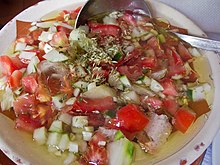Gazpacho
This article needs additional citations for verification. (September 2019) |
 Gazpacho | |
| Alternative names | Andalusian gazpacho, Gaspacho |
|---|---|
| Course | Appetizer |
| Place of origin | Spain, Portugal |
| Region or state | Andalusia, Alentejo, Algarve |
| Serving temperature | Cold |
| Main ingredients | water, olive oil, vinegar, garlic, tomato, cucumber, other vegetables |
| Variations | Salmorejo, ajoblanco |
| variable kcal | |
Gazpacho (Spanish: , particularly during hot summers, since it is refreshing and cool.
Although there are other recipes called gazpacho, such as gazpacho manchego, the standard usage implies a soup. There are also a number of dishes that are closely related and often considered variants thereof, such as ajoblanco, salmorejo, pipirrana, porra antequerana (closer to a bread soup), and cojondongo.
History
There are many theories as to the origin of gazpacho, including one that says it was a soup of
There are many modern variations of gazpacho with
Ingredients and preparation
Most gazpacho includes stale bread, tomato, cucumbers, onion, bell peppers, garlic, olive oil,
Traditionally, gazpacho was made by pounding the vegetables in a mortar with a pestle; this more laborious method is still sometimes used as it helps keep the gazpacho cool and avoids the foam and silky consistency of smoothie versions made in blenders or food processors.[5][7][8][9] A traditional way of preparation is to pound garlic cloves in a mortar, add a little soaked stale bread, then olive oil and salt, to make a paste. Next, very ripe tomatoes and vinegar are added to this paste. In the days before refrigeration, the gazpacho was left in an unglazed earthenware pot to cool by evaporation, with the addition of some water.[10]
Gazpacho may be served alone or with garnishes, such as hard-boiled eggs, chopped ham (in the salmorejo variety from Córdoba), chopped almonds, cumin crushed with mint, orange segments, finely chopped green bell peppers, onion, tomato or cucumber.[10] In Extremadura, local ham was added to the gazpacho itself rather than as a garnish; this is called gazpacho extremeño. Andalusian sources say that gazpacho should be slightly chilled, but not iced.[10]
Variations

The ingredients, texture, and thickness of gazpacho vary regionally and between different cooks.
Similar cold raw soups such as arjamolho in Portugal, porra antequerana and ajoblanco, are also popular in Andalusia, although not as widespread as gazpacho. Gazpacho and salmorejo are especially similar since they are both tomato-based cold soups that are widely popular in Spain; the main difference between gazpacho and salmorejo is the culinary technique used [11] since gazpacho is a soup whereas salmorejo is an emulsion. In addition, while both dishes share the main ingredients of tomato, olive oil, bread, and garlic, gazpacho can also be prepared with cucumber, peppers, and vinegar, whereas salmorejo cannot.
In Spain
The original recipe using bread, water, vinegar, oil, and salt is traditional in the
Arranque roteño
A popular variation comes from the town of
Extremaduran variations

In
La Mancha variations
Gazpacho manchego, as its name implies, is made in the east region of La Mancha, in Albacete and nearby areas, and is popular in other areas in the center and southwest of the country.
It is a meat stew, whose main ingredients are small
. It is cooked in a cauldron and served hot. Another well-known variant in La Mancha is gazpacho de pastor or galiano.Some other hot meat or fish dishes from other regions are called gazpacho (gazpacho jumillano, gazpacho de Yecla, gazpacho de Requena, etc.)
Castilian variations
Gazpacho is often eaten during the very hot and dry summers in
See also
References
- ^ Oxford English Dictionary, 2nd. ed cites R. Ford Hand-bk. Travellers in Spain I. i. 69 (1845) "Gazpacho...is a cold vegetable soup composed of onions, garlic, cucumbers, pepinos, pimientas, all chopped up very small and mixed with crumbs of bread, and then put into a bowl of oil, vinegar, and fresh water."
- ^ Steven Raichlen (30 August 1989). "Gazpacho: Theme And Variations". The New York Times.
- ^ Etimología de gazpacho (caccabaceus). Retrieved 11 December 2023.
- ^ Facts about Gazpacho Clifford A. Wright. Retrieved 6 July 2007.
- ^ a b Kate Heyhoe. "Last Blast Gazpacho: Tomato and Watermelon at Summer's End". Kate's Global Kitchen. Archived from the original on 18 August 2009. Retrieved 7 June 2009.
- ^ "gazpacho". Royal Spanish Academy.
- ^ Amiel Stanek (31 July 2017). "Green Gazpacho Is Just a Savory Green Smoothie". Bon Appetit.
- ^ Joe Yonan (6 July 2011). "Green Gazpacho (or Smoothie)". Washington Post.
- ^ Laura D'Ocon (21 June 2021). "Gazpacho: A Classic Way to Spice Up Your Smoothie With Veggies!". Foods and Wines from Spain.
- ^ a b c King Gazpacho, Andalucia magazine. Retrieved 1 April 2022.
- ^ "Directo al Paladar". 21 June 2016.
- ^ Cojondongo del gañán Archived 25 April 2012 at the Wayback Machine en la web de Turismo de la provincia de Badajoz.
- ^ Lescure Beruete, Luis Felipe. DICCIONARIO GASTRONÓMICO. Términos, Refranes, Citas y Poemas (2005) p.71
- ^ Gazpacho Manchego
- ^ Wikibooks: recipe for gazpacho morañiego. (in Spanish)
